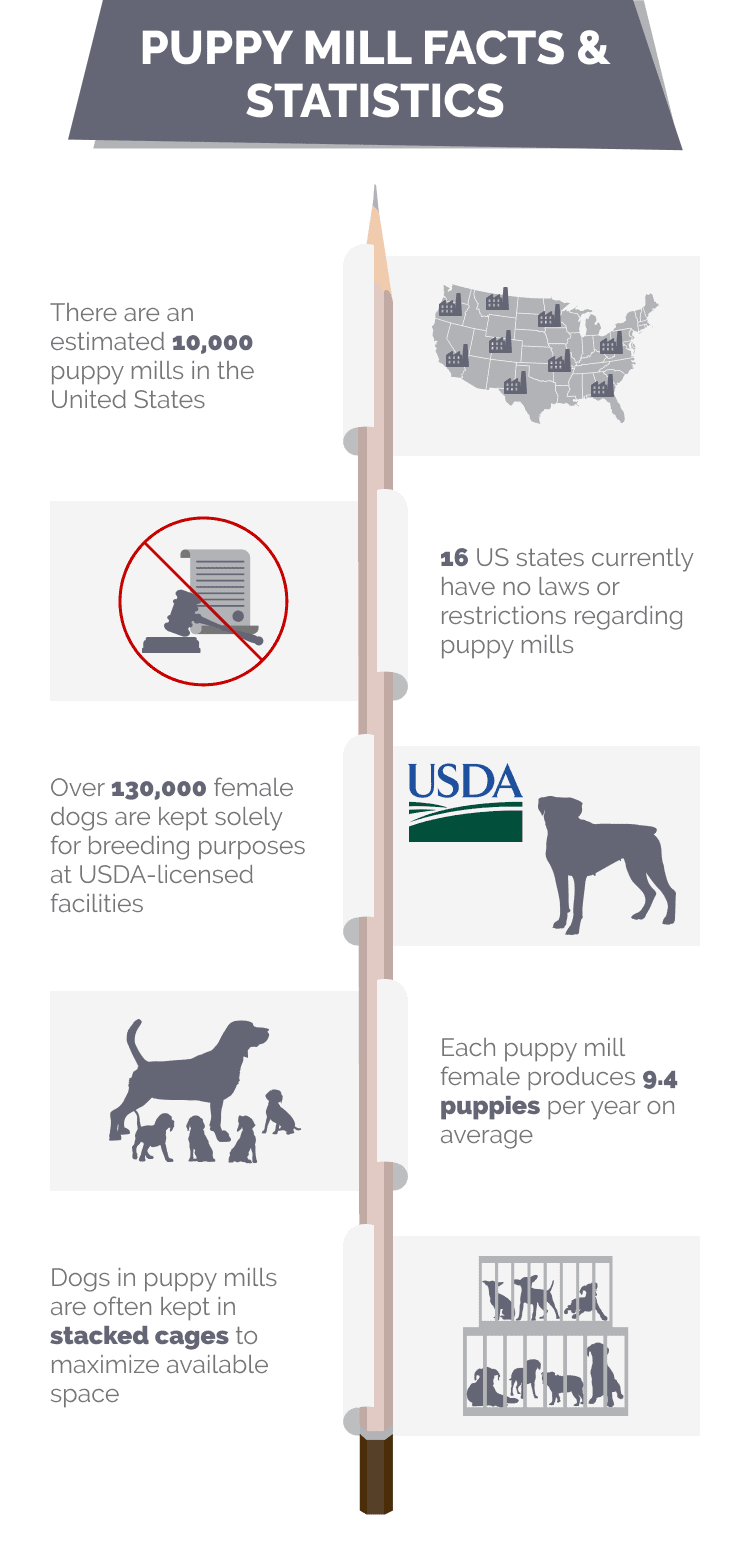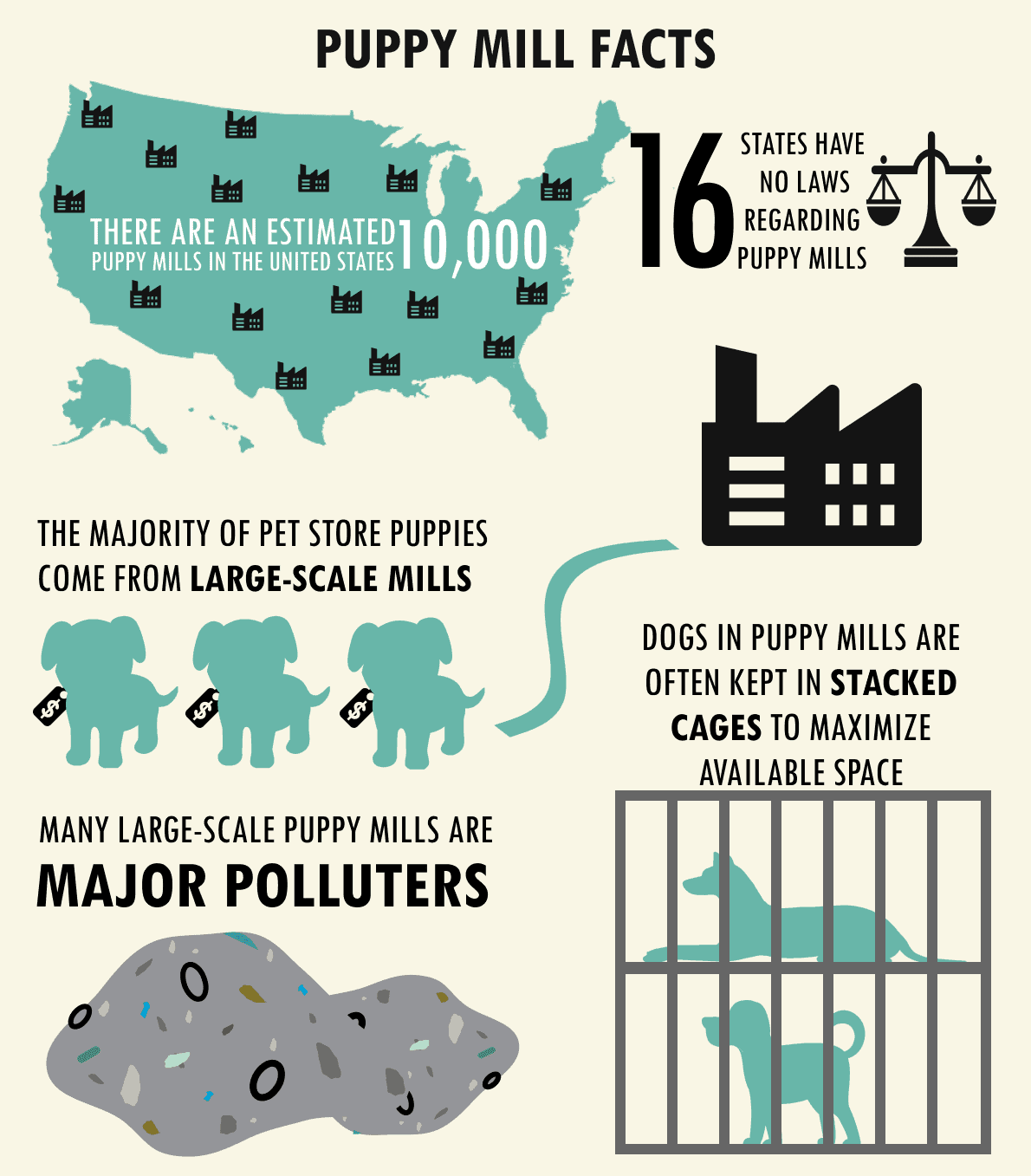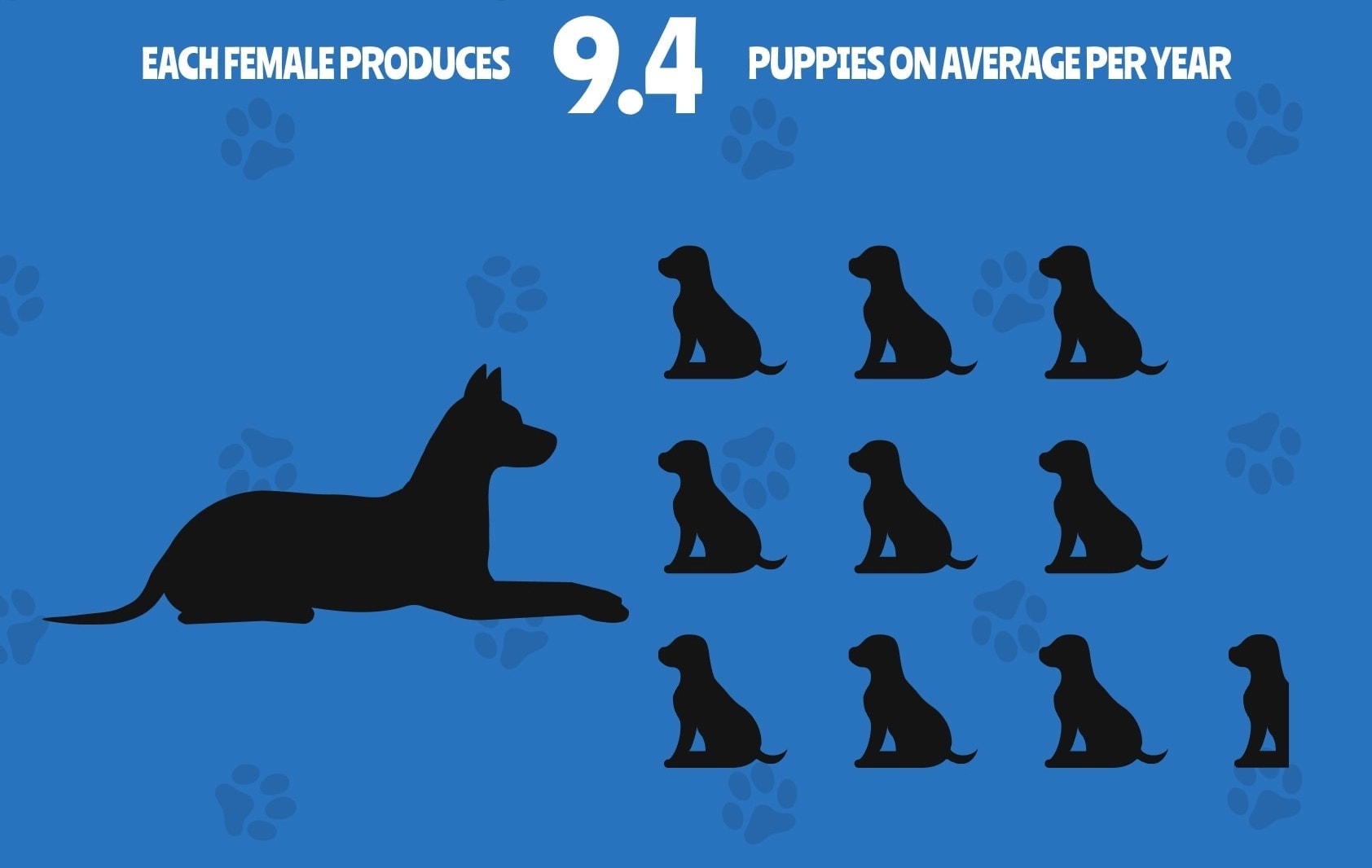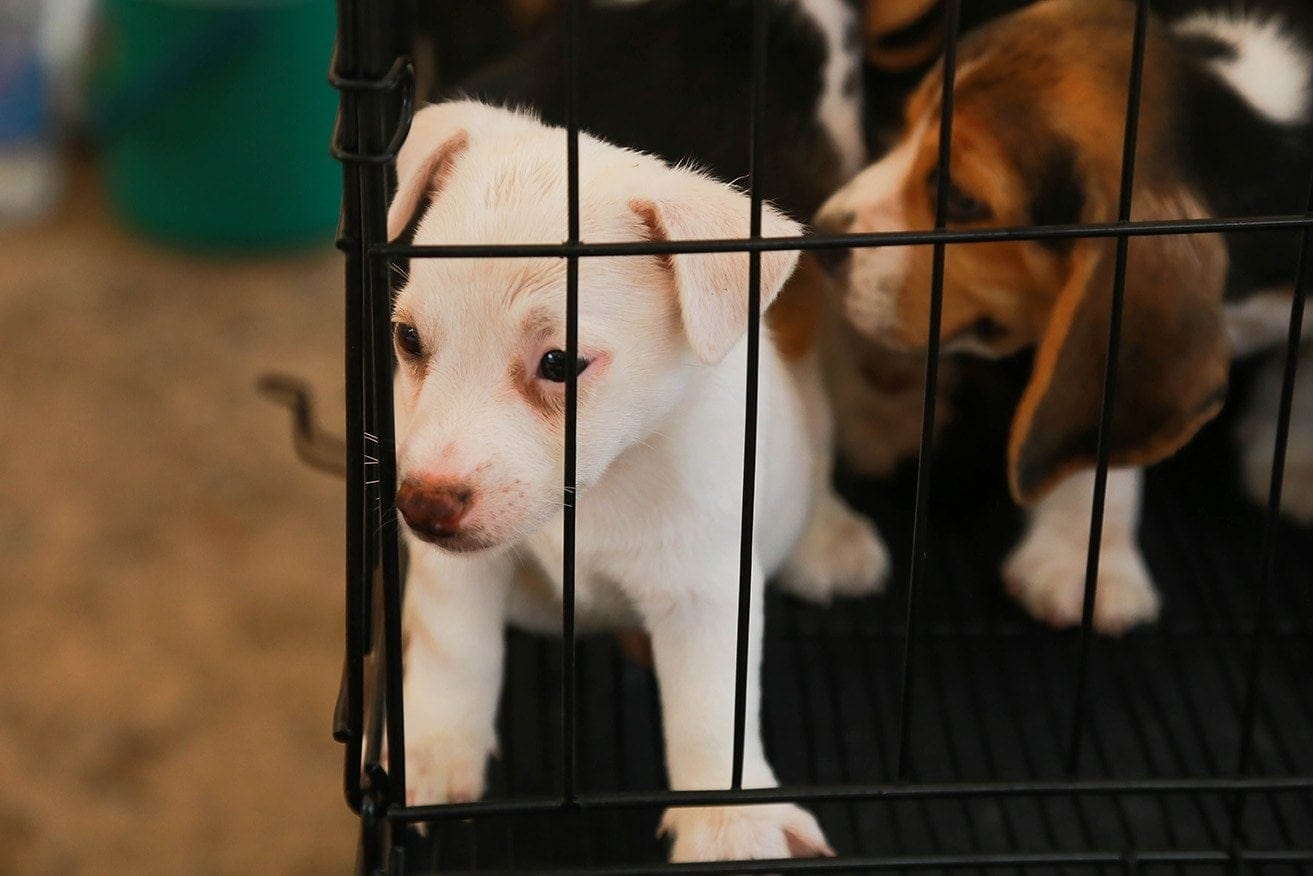15 Shocking Puppy Mill Facts & Statistics to Know in 2024

Updated on

Puppy mills are the disgusting underside of the pet industry. According to the American Society for the Prevention of Cruelty to Animals, a puppy mill is “any large-scale commercial dog breeding operation where profit is given priority over the well-being of the dogs.”
Any dog you buy from a breeder or pet store could have come from a puppy mill. Not only is that bad for the animals, but it could also increase the risk that your dog will display behavioral issues later in life.
Unfortunately, it can be difficult to know whether that puppy you have your heart set on is the product of a mill or not. However, we believe that with increased education and awareness, you can limit the chances of unwittingly supporting one of these cruel organizations.
To that end, we’ve prepared little-known facts and figures about this shadowy industry. The stats and facts below might surprise you, but hopefully, they’ll also show you how to bring home your next dog without sacrificing your ethics along the way.
Top 15 Puppy Mill Statistics
- There are an estimated 10,000 puppy mills in the United States.
- The vast majority of pet store puppies come from large-scale mills.
- Sixteen states have no laws regarding puppy mills whatsoever.
- Only about 24% of all puppy mills are USDA licensed.
- Over 500,000 dogs are kept solely for breeding purposes at USDA-licensed facilities.
- Each female produces 9.4 puppies per year on average.
- There are approximately 920,000 shelter animals that are euthanized each year.
- Puppy mills are often overcrowded and unsanitary, leading to health problems for the dogs inside.
- Dogs in puppy mills are often kept in stacked cages to maximize available space.
- Dogs removed from puppy mills show persistent behavioral and psychological abnormalities.
- Dogs who die in puppy mills are often dumped unceremoniously rather than given proper burial or cremation.
- Many large-scale puppy mills are horrific polluters.
- Puppies that make it out of mills can carry deadly diseases.
- Mills that breed purebred puppies often contribute to the degradation of the breed.
- Legislators in some states are beginning to take aim at ending the mill-to-store pipeline.

Puppy Mill Statistics
1. There are an estimated 10,000 puppy mills in the United States.
Many people believe that puppy mills are rare or that they’re isolated to only a few parts of the country. However, the data clearly shows that puppy mills can be anywhere and that they aren’t limited to only a few geographic locations.
2. The vast majority of pet store puppies come from large-scale mills.
Puppy mills exist for one reason only: to produce dogs as cheaply as possible. When you consider that pet stores want to keep their costs and margins high, it only makes sense that they’d get most of their animals from mills.
While this might make good business sense for the pet stores, it’s morally repugnant. Moreover, dogs acquired from puppy mills are more likely to have a host of health issues, making them a bad investment for anyone who brings one home.
3. Sixteen states have no laws regarding puppy mills whatsoever.
While the severity of restrictions regarding puppy mills can vary from state to state, there are currently 16 states without any restrictions on puppy mill activity. That means these facilities are never licensed nor inspected, and there are effectively no limits on what the breeders can do there.
Other states license commercial mills and restrict what can happen there but rarely, if ever, inspect them. Only 18 states license mills and inspect them regularly.

4. Only about 24% of all puppy mills are USDA licensed.
While the laws regarding commercial mills may be lax in some places, at least some facilities follow whatever regulations exist. Unfortunately, these mills seem to be in the minority.
The lack of licensing means there’s no way of knowing what’s happening at these facilities. That throws many of the existing statistics off; they’re either educated guesses or apply only to licensed facilities.
5. Over 500,000 dogs are kept solely for breeding purposes at USDA-licensed facilities.
These dogs have no purpose other than to be bred, carry the puppies to term, and then nurse them for the first few weeks of their lives. These dogs don’t play, get exercise, or have any respite from reproduction.
This is bad for their mental health, but it also puts a tremendous toll on their bodies. These mothers aren’t healthy, and more often than not, neither are the puppies they produce.
Also, it’s important to note that this statistic only applies to USDA-licensed facilities; there’s no way to know how many breeding females are kept in unlicensed mills.

6. Each female produces 9.4 puppies per year on average.
Over 1.2 million puppies are created per year at these licensed facilities. However, given that the mills only represent 24% of all mills, you may be able to multiply that number by four before you get a figure that approaches the truth.
That’s assuming that unlicensed mills follow the same standards and practices as licensed facilities. As a result, you could be looking at well over 5 million puppies produced in mills each year.
7. There are approximately 920,000 shelter animals that are euthanized each year.
When you factor in all the unwanted animals put down each year due to lack of a suitable home, it becomes much harder to justify buying a pet, regardless of the breeder’s reputation.
Ironically, many people avoid shelter animals because they feel that the pets would be “defective” in some way. However, dogs that come from puppy mills are much more likely to have severe health or behavioral issues.
This is partially due to the poor conditions in which they’re raised, but it’s also largely because shelters perform behavioral screenings before letting an animal be adopted. A dog you get from the shelter has had temperament testing at the very least; a dog from a puppy mill comes with no such guarantees.
8. Puppy mills are often overcrowded and unsanitary, leading to health problems for the dogs inside.

Dogs rescued from puppy mills often suffer from serious conditions like parasites, dental problems, and eye issues. This can cost the organizations that take them thousands of dollars in veterinary costs.
The conditions in your average puppy mill are so cramped that if one dog gets sick or is exposed to parasites, there’s a good chance that every dog will soon follow suit. Also, given that medical care is expensive, many breeders won’t take action to solve these issues, preferring instead to let the animals suffer or die.
9. Dogs in puppy mills are often kept in stacked cages to maximize available space.
Keeping dogs in cages full-time makes it easier to care for them. You don’t have to chase them down to feed them or check on their puppies. However, it also makes the dog miserable, especially when there are other dogs above, below, and on either side of them.
The cages are often stacked so high that mill workers can’t easily see inside them to check on the dog’s well-being. They’re not often cleaned, either, and in some mills, workers have to wear gas masks to protect against the accumulated ammonia odors.
10. Dogs removed from puppy mills show persistent behavioral and psychological abnormalities.
It’s not exactly surprising that living in conditions like those described above would cause immense stress. That stress builds up over time, causing severe behavioral issues.
These issues are primarily limited to the adult dogs used as breeding stock since puppies are removed from the facility within a few weeks of birth, which is too soon for the conditions to have a serious psychological effect.
However, this makes it difficult to rescue dogs from mills or shut them down permanently, as the animals may not be suitable candidates for re-homing.
11. Dogs who die in puppy mills are often dumped unceremoniously rather than given proper burial or cremation.

Given the conditions often present in puppy mills, it should come as no surprise that many animals never make it out alive. Whether they die from disease, neglect, or exhaustion after years of overbreeding, most mills have to deal with a large number of dead dogs.
In one case in Missouri, authorities found that a puppy mill was dumping dozens of dead animals in the woods near the facility. These animals weren’t even buried; they were just left in the open.
While that’s disrespectful to the dogs, it also increases the risk that their corpses will spread disease, making the practice a valid public safety concern.
12. Many large-scale puppy mills are horrific polluters.
A 2008 study followed the environmental impact of a single puppy mill in Parkersburg, West Virginia. Researchers found that the mill frequently violated the state’s water pollution and solid waste statutes.
The facility was illegally dumping animal waste; during storms, water would carry the waste off into freshwater sources. One sample taken from a nearby water supply found that the water contained more than 80,000 coliform bacteria per 100 ml of water; to put that in perspective, the legal limit was 200 bacteria.
The unsanitary conditions inside many mills are bad for the dogs, but they can cause health issues for people in the surrounding area as well.
13. Puppies that make it out of mills can carry deadly diseases.
In 2019, at least 30 people were affected by the Campylobacter jejuni bacteria, a multidrug-resistant infection. It’s believed that they caught the bug from contact with puppies at pet stores.
This infection can cause bloody diarrhea, fever, and stomach cramps. It’s believed to be responsible for 200 deaths per year in the United States.
14. Mills that breed purebred puppies often contribute to the degradation of the breed.

Many breeds, like English Bulldogs and Bernese Mountain Dogs, have encountered severe health problems due to extensive inbreeding. These issues include high incidences of cancer, breathing problems, difficulties giving birth, and more.
Most puppy mills do little to vary the genetic makeup of the dogs they’re creating. In fact, they often try to accentuate the most attractive aspects of the breed, which can have long-term negative impacts on the dogs.
Responsible breeders will contribute more to the breed’s overall health as they care deeply for the dogs. Mills, however, are only concerned with profit; the well-being of the dogs is a distant consideration if it comes up at all.
15. Legislators in some states are beginning to take aim at ending the mill-to-store pipeline.
In 2019, California became the first state to ban the sale of any dog, cat, or rabbit in a pet store unless that animal had been acquired from a public or private animal shelter or rescue group.
Pet stores can still sell animals to the public, but this legislation reduces the prominence of the puppy mills since they lost their biggest customers overnight.
It’s too soon to tell what impact this new bill will have, but it seems like a step in the right direction for finally ending this cruel commercial practice.
What Is So Wrong With Puppy Mills?
Puppy mills are large-scale commercial enterprises whose only aim is to make as much money as possible by selling puppies. They give no thought to the well-being of the breeder animals, nor do they particularly care about the long-term health of the puppies after they’ve been bought and paid for.
The animals that live in puppy mills often have to endure barbaric conditions. They’re kept in stacked wire cages that are seldom cleaned, they don’t get any fresh air or exercise, and they’re vulnerable to various diseases.
There’s no concern for the long-term health of the breed, and many mills are contributing to the degradation of the gene pool. This can lead to the preponderance of health issues in adopted dogs.
Dogs from puppy mills also crowd out animals that are kept in kill shelters. Millions of animals in those shelters are euthanized each year, while pet stores sell millions of animals from puppy mills. Without the mills, more shelter animals would undoubtedly find homes.
Where and to Whom Do Puppy Mills Sell To?
For the most part, puppy mills sell to pet stores. The vast majority of animals sold in pet stores come from large-scale breeding operations. There’s a simple reason. Puppy mills keep costs low, and pet stores try to maximize profits. The dogs are seen as merely dollar signs rather than living beings, and the lower the cost, the happier the pet store owners will be.
There are signs that this is changing, due in large part to public pressure. California has already banned the sale of mill puppies, and other states will likely follow suit in the years to come.
It should be noted, however, that many smaller mills sell directly to the public. These backyard breeders usually offer purebred animals at deep discounts; they can undercut legitimate breeders because they don’t provide proper nutritional support or veterinary care.
How Can I Distinguish a Good Breeder From a Puppy Mill?
As noted above, the biggest red flag is a price that’s too good to be true. If you can find a breeder offering a purebred pup for a fraction of what other sellers are asking, it’s a clear sign that their overhead is lower, and mill-like practices are likely the reason.
You can also avoid shady breeders by asking for references. Most legitimate breeders rely on word-of-mouth to drive their business, so the long-term satisfaction of their customers is vital. They may even track how their puppies fare after being sold.
On the other hand, puppy mills are only concerned about moving products. Anything that happens after that is largely irrelevant to them, so they’re unlikely to be able to produce positive references from past customers.
If at all possible, inspect their facilities in person. This will let you see first-hand the kind of conditions they’re kept in and give you the opportunity to gauge the temperament of the dogs produced by the breeder.
Of course, you can sidestep the issue entirely by adopting a dog from a local shelter or rescue group. Their dogs are just as good, and you can rest assured that you’re saving a life.
Conclusion
Bringing home a new puppy is one of life’s greatest joys, but before you select your next dog, consider where it might have come from. Many animals, especially those sold in pet stores, are the products of puppy mills, which keep their animals in horrific conditions.
There is hope, however, that this inhumane practice may be on its last legs. Many state legislatures have considered banning the sale of mill-produced puppies, and California has already done so. Public awareness of the issue is also higher than ever, causing many pet stores to stop selling mill puppies due to public pressure.
There’s no reason to buy a puppy from a mill. Legitimate breeders, animal shelters, and rescue groups can all provide you with a fantastic pet that was produced using ethical practices.
If you want a dog, then by all means, get one. However, you owe it to your future pet and their relatives to do your due diligence to ensure the dog doesn’t come from a puppy mill.











